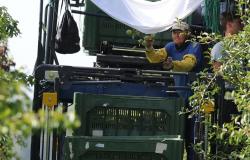Cinema has shown us, often in an imaginative way, how humanity could react when faced with the risk of impact with large asteroids which would threaten the existence of all of us. Since this is cinematic fiction, these undertakings always have a positive outcome, ending up saving the Earth from destruction.
The film, however, must deal with reality. If what is told in the films became real we would all be seriously at risk and survival would not be just a matter of heroism. Not only that. The latest revelations about a NASA shield capable of protecting us are very discouraging.
If on the one hand it is believed that an asteroid will save humanity due to the forced cooperation between peoples that such an event would require, on the other hand we may not be ready at all for such a destructive event.
The NASA shield won’t block a large asteroid
The shield NASA Asteroid Policy refers to technologies and strategies designed to protect Earth from asteroid impacts. These efforts are part of the Planetary Defense Coordination Office (PDCO), which deals with the surveillance and mitigation of threats coming from near-Earth objects (Near-Earth Objects, NEOs).
Protection goes through multiple steps. The first concerns the detection and the consequent monitoring of the space object. NASA uses a network of ground-based telescopes and satellites to detect and track asteroids and comets approaching Earth. The detected objects are then catalogued and monitored to determine their orbits and assess impact risk. The danger assessment is based on orbital calculations and simulations, performed to calculate the effects of a possible collision.
Only if it is established that the threat is real, then we will move on to the actual defense strategy, starting from deflection of asteroids. That is, we would study how to deviate the asteroid from its impact trajectory, through various techniques.
In short, well-studied methodologies that should make us sleep peacefully between two pillows. But the conditional is a must. If one of these steps has a flaw, the entire system collapses. Here’s the latest information on asteroid detection and tracking does not allow for optimism. The latest planetary defense exercise conducted by NASA, in fact, confirmed that we are not ready to defend ourselves. This is because a potentially dangerous asteroid is about to pass overhead and was discovered only a few days in advance, insufficient to be able to prepare and adopt any form of defense, but enough to say that NASA will not block an asteroid headed towards Earth. Not only that: even in the case of advance prediction, the Fifth Biennial Planetary Defense Exercise coordinated by NASA with other US and international partners, it indicates that we do not yet have a common and well-defined strategy to defend ourselves. Political decisions, lack of funding, lack of international coordination and inadequate communication are all crucial factors that would contribute to the catastrophe.
Two asteroids heading towards Earth in June: the risks
On June 16, 2024, a surveillance telescope in South Africa discovered a potentially hazardous asteroid called 2024 MKready to pass through the skies by the end of the month at a very short distance from an astronomical point of view, equal to 293,000 kilometres. Let’s clarify straight away: there is no risk of impact and therefore no risk, at least on this occasion. But discover such a wide object 270 meters with only a few days ahead of its flyby, it raises more than a few doubts about our ability to defend ourselves from a collision.
2024 MK is not the only object that will pass through the skies between 27 and 20 June 2024. The second asteroid has the name of 2011 UL21 and compared to the one just described it has kilometer dimensions. However, it will pass considerably further from our planet, a few million kilometers away.
Ironically, these two space objects will transit just a few hours earlier than usual. World Asteroid Day (Asteroid Day) which is celebrated on June 30th of each year. The event was born in memory of the asteroid that devastated in 1908 there Tunguska region in Siberia. It was a celestial body only about fifty wide meters, however sufficient to devastate over 2,000 square meters of Siberian taiga.





